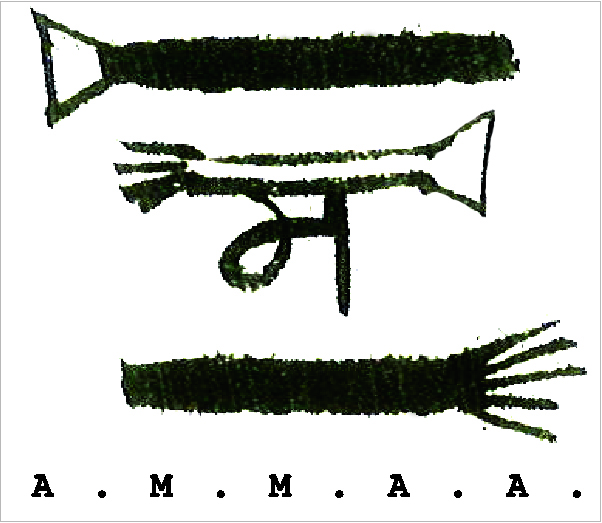The First A.M.M.A.A. Poster ( June 1, 2016)
The A.M.M.A.A. Website Launch Poster ( April 15, 2017 )
Manifesto
Aim- To create a space for the documentation of experiences and creative expressions by mother artists; in contemporary visual and performing arts , with focus on the Asian region.
Core - Both Mapping and Visibility form the core of A.M.M.A.A.
Modus Operandi- Creating an online archive, for the documentation and dissemination of information, on the work done by Mother Artists of Asian origin. The archive has been structured to incorporate both compact and comprehensive information . Building a sense of inclusiveness, A.M.M.A.A. has also welcomed mother artists who have spent a considerable part of their lives in Asia.
About the Researcher
Ruchika Wason Singh (Ph.D) is a mother artist based in Delhi, India. She has taught as Associate- Professor in the Dept. of Painting, B.F.A., College of Art, New Delhi. Ruchika has been a U.G.C. Junior Research Fellow at University of Delhi (2001-2006). She is a Visiting Faculty at Ashoka University,Sonipat, India.
Ruchika lives with her husband Gagandeep and their twenty year old daughter Meher and their extended family ; balancing her life as an artist, homemaker and an academician.
The Concept
A.M.M.A.A. simply means mother. It is also a space, for mapping mother artists in Asia and their art practice. A.M.M.A.A. is an initiative by Indian artist Ruchika Wason Singh, to document the different aspects of their art making and its possible relations with motherhood . The archive should serve as a space, both to make and claim , for and by mother artists in Asian countries; through their commitment to create despite maternal and domestic responsibilities.
The Story behind A.M.M.A.A.
In the summer of 2016, I conceived the idea of a space for mother artists, which could give visibility to women, who had made the choices of both motherhood and art practice in their lives, but not necessarily had the opportunity to find visibility for their work. My idea sprung from two points of departure. First, my own joyful experience of mothering , which brought along , challenges of artistic activity and mobility for me . Second, the knowledge that much research has been done outside of Asia on the role of mothers / artists ,its impact on their art and life ; but a lacuna within the Asian region was very much present and needed attention.
I began with a blog which I started on 1 June 2016 and launched an open call.
https://ammaathearchive.wordpress.com
https://ammaathearchive.wordpress.com/2016/06/08/blog-post-title/
I received mixed responses from artists and friends. There was surprise, curiosity, scepticism, denial, acceptance and warm welcome. To my surprise, I also received interest in the project from mother artists who either had ancestral Asian roots or were of non-Asian origin, but had spent considerable time of their lives in Asia. It brought me to understand the impact which A.M.M.A.A. had and also the need to make it inclusive.
Slowly, I began to work on the A.M.M.A.A. website and its possible sections, which could both compartmentalise and share information on the work done by mother artists . Since A.M.M.A.A. is focused on Asia , it meant that diverse languages as the preferred language of communication exist . Documentation due to geographical and linguistic restrictions, has been at the very outset, quite a challenge for me. Often the material for the research could not reach me , as English was not the preferred language of communication for many mother artists outside of India. Unlike in the case of Miharu Hatori in Japan , whom I also had the privilege to meet in person in Tokyo in 2016 ; I was fortunate for two reasons. Firstly, that the artist could converse in basic English, and secondly , my friend Yasuko Oki ( a photographer based in Yokohama) volunteered to play the role of a translator for us (please see the section In Focus-Conversations). This limitation has sometimes made me work on certain negotiations with the artists, on the availability / submission of the research material. But considering that my prime focus has been on mapping, I feel privileged to be in touch with and learn about so many diverse practitioners , with whom I share a solidarity of motherhood and creativity.
I am very hopeful that A.M.M.A.A. becomes a space for realising ideas on trajectories of mapping, visibility and mobility of mother artists of Asian origin, living within and outside of Asia.
Future Strategies-
Continuing research on mapping mother artists of Asian origin , living within and outside of Asia.
Developing new models for the dissemination of information, about the work done by mother artists . These are -
-Online Curated Exhibitions
- Publications
Creating new opportunities through collaborations.
The A.M.M.A.A. Artist Residency for short -term mobility of mother artists.
Sincere Acknowledgements : Luise Guest (Australia), Arthur Huang , Sayaka Ashidate , Yasuko Oki , James Jack (Japan) ; Nguyen Anh-Tuan (Vietnam); Van Thi Tran (Laos); Ganesh Gohain, Rajan Fulari ,Niva Devi, Shijo Jacob (India).


